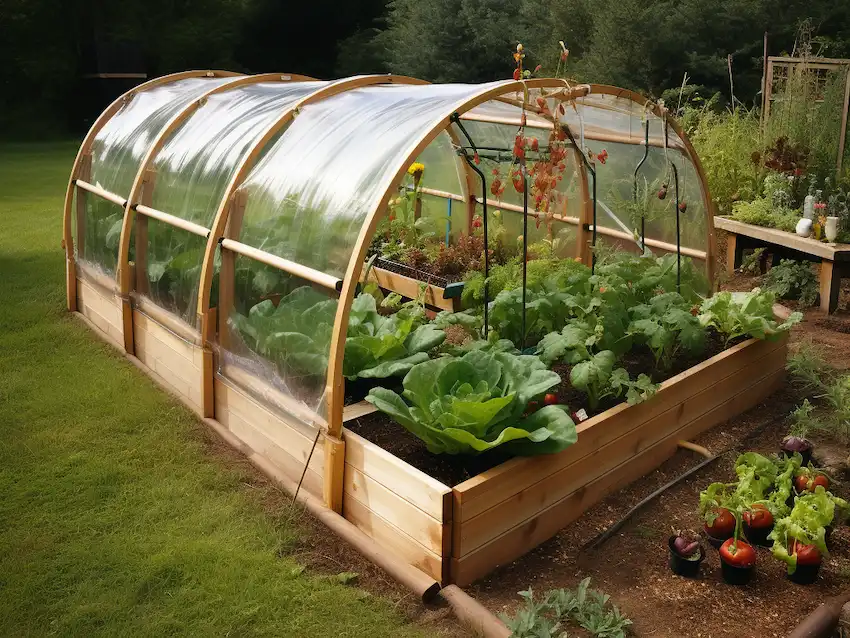Creating a hinged hoophouse for your raised bed garden is a fantastic way to extend the growing season, protect your plants from adverse weather conditions, and keep pests away. A hoophouse is essentially a small greenhouse that can be easily moved or adjusted. The addition of a hinged feature allows for easy access and ventilation. Here’s a detailed guide to building your own hinged hoophouse:
Materials and Tools Needed
- PVC Pipes: For the frame of the hoophouse.
- PVC Fittings: Including elbows and connectors.
- Hinges: For attaching the door to the frame.
- Plastic Sheeting: To cover the hoophouse.
- Wooden Boards: For the base and door (optional, if you prefer a more robust frame).
- Screws and Nuts: For assembly.
- PVC Cutter or Saw: For cutting PVC pipes.
- Drill: For making holes and attaching hinges.
- Measuring Tape: For accurate measurements.
- Scissors or Utility Knife: For cutting plastic sheeting.
- Staples or Glue: To attach the plastic sheeting.
- Zip Ties: For securing plastic sheeting and other components.
Step-by-Step Instructions
1. Plan Your Hoophouse
- Measure the Raised Bed: Determine the dimensions of your raised bed garden. The hoophouse should be slightly larger than the bed to fit comfortably.
- Design the Hoophouse: Decide on the shape and size of your hoophouse. A common design is a semi-circular arch that spans the width of the bed, with a hinged door for easy access.
2. Construct the Frame
- Cut PVC Pipes: Based on your measurements, cut the PVC pipes to the desired lengths. You’ll need pipes for the arches, sides, and door frame.
- Assemble Arches: Use PVC fittings to connect the pipes and create the arches that will form the top of the hoophouse. Connect two arches at each end to form a semi-circular structure.
- Build the Base: Create a rectangular or square base frame using PVC pipes. This will support the hoophouse and attach it to the raised bed.
- Attach Arches to Base: Secure the arches to the base frame using PVC connectors or by drilling and fastening the pipes together. Ensure the arches are evenly spaced and aligned.
3. Create the Hinged Door
- Construct the Door Frame: Use PVC pipes or wooden boards to build the door frame. It should be the same width as one of the arches.
- Attach Hinges: Secure hinges to one side of the door frame and attach them to the hoophouse frame. Ensure the door opens and closes smoothly.
4. Cover the Hoophouse
- Cut Plastic Sheeting: Measure and cut the plastic sheeting to cover the entire hoophouse. Allow extra material for overlapping edges and securing.
- Attach Plastic Sheeting: Drape the plastic sheeting over the frame. Use staples or glue to secure the sheeting to the PVC pipes or wooden frame. Make sure the sheeting is tight and free of wrinkles.
- Seal the Edges: Use zip ties or additional staples to secure the edges of the plastic sheeting to the base frame. Ensure there are no gaps where air or pests can enter.
5. Install the Hoophouse
- Position the Hoophouse: Place the assembled hoophouse over the raised bed garden. Adjust its position to ensure it fits properly and covers the entire bed.
- Secure the Hoophouse: Anchor the base of the hoophouse to the ground using stakes or weights. This will prevent it from moving or being lifted by the wind.
6. Final Adjustments
- Check the Hinged Door: Ensure the door opens and closes properly. Adjust the hinges or door frame if necessary.
- Ventilation: If the hoophouse is too warm or humid inside, consider adding vents or additional hinges to improve airflow.
- Inspect for Gaps: Check for any gaps or areas where the plastic sheeting is not securely attached. Make any necessary repairs to maintain the effectiveness of the hoophouse.
Benefits of a Hinged Hoophouse
- Extended Growing Season: Protects plants from frost and allows for year-round gardening.
- Weather Protection: Shields plants from harsh weather conditions like wind, rain, and snow.
- Pest Control: Keeps pests out and reduces the risk of plant damage.
- Accessibility: The hinged door provides easy access to your plants for maintenance and harvesting.
Maintenance Tips
- Regular Cleaning: Clean the plastic sheeting periodically to remove dirt and algae buildup.
- Inspect for Damage: Regularly check for any tears or damage to the plastic sheeting and repair as needed.
- Ventilation: Ensure proper ventilation inside the hoophouse to prevent overheating and humidity buildup.
By following this guide, you can build a functional and effective hinged hoophouse for your raised bed garden, enhancing your gardening experience and ensuring healthier, more productive plants throughout the year.
